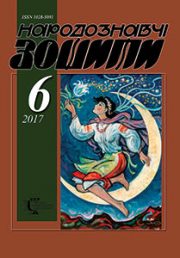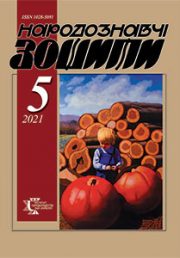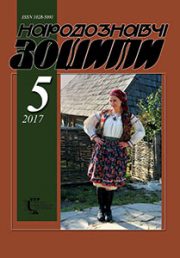The Ethnology Notebooks. 2019, № 5 (149), 1260—1267
UDK 398.83:392.51:133:7.045/.046](=161.2)
DOI https://doi.org/10.15407/nz2019.05.1260
UKRAINIAN BRIDAL SONG ABOUT THE GREAT DREAM OF THE BRIDE: MOVING THROUGH SPACE-TIME
PASTUKH Nadiia
ORCID ID: https://orcid.org/0000-0001-7703-5541
Candidate of Philological Sciences (Ph. D. in philology),
Senior Researcher at the Ethnology Institute of
National Academy of Sciences of Ukraine,
15, Svobody Avenue, 79000, Lviv, Ukraine
е-mail: npastukh@gmail.com
Abstract. The overall national picture in folklore always consists of a regional mosaic. Similarly, the national symbolic system of folklore appears as the sum of individual symbolic systems of regional traditions.The study of the regional character of symbolism of Ukrainian wedding songs has become possible today thanks to the existence of a relatively «dense grid» of field records (both ancient and modern), as well as in view of the long multi-vector and thorough understanding of «poetry of marriage» since the first half of the 19th century. The regional segment in the symbolic system is, at first, clearly not noticeable, such that it does not prevent the symbol from moving freely in space, does not obscure its meaning. It is possible to identify it only on the basis of comparative microanalysis of the wedding symbolic world of the regions on the scale of the Ukrainian folk symbolic tradition. Despite the permanent scientific interest of folklorists in Ukrainian wedding song, many texts from the national fund, especially with complex multi-layered symbolic structures, have remained without scientific interpretation and proper analysis in terms of their regional features and stage changes. The relevancy of the article is in fact an attempt to trace the movement of a particular wedding song, namely, a symbolic picture in it, in space and time. The aim of the article is to analyse the symbolism of the wedding song about the dream of the bride, in particular to find out the semantics of key symbols, to outline their paradigm based on different local and regional variants, to trace the stage changes in the imagery of the higher dream, and to identify trends and causes of such changes. The object of the study is a wedding song, spread throughout the territory of Ukraine, with a story about the bride’s dream, and the subject is a symbolic picture that unfolds during the retelling of the dream, its content, regional versions and the stage changes therein. The source of the work consists of texts of Ukrainian wedding songs (presented in the context of the rite or without it), which were published during the 19th—21st centuries in folklore collections, monograph studies and articles. There were also involved our own materials from Western Polissya (2000, 2005), Nadsyanya (2003), Precarpathian Podnistrovja (2003), East Podillya (2004, 2005, 2006), West Podillya (2006), Boykivshchyna(2006, 2007). The study used comparative, structural-semiotic and historical-genetic methods.
Keywords: wedding song, symbolic structure, prophetic dream of the bride, semantics, rite, black silk, silver-gold, falcons, viburnum.
Received 18.10.2019
REFERENCES
Kostomarov, M.I. (1994). On the historical importance of Russian folk poetry. In M.I. Kostomarov, Slavic mythology. Selected works on folklore and literary studies (pp. 280—296). Kyiv [in Russian].
Okhrimovych, Vl. (1891). Importance of the Ukrainian wedding rites and songs in the history of family evolution. Ethnographic Review, 4, 44—105 [in Russian].
Yashchurzhinskyi, Chr. (1880). Lyrical Ukrainian songs, mostly wedding songs, compared to Russian. Russian Philological Bulletin (Vol. 3. pp. 36—85; pp. 230—279; Vol. 4. pp. 1—32) [in Russian].
Yashchurzhinskyi, Chr. (1896). Ukrainian wedding as a religious household drama. Kievan Past (Vol. 11, pp. 234—273) [in Russian].
Potebnya, A. (1865). About mythical meaning of some rituals and beliefs. Moscow [in Russian].
Potebnya, A. (1883—1887). Explanation of Ukrainian and related folk songs: in 2 volumes. Warsaw: Printing house of M. Zemkevich and V. Noskovsky [in Russian].
Romanyuk, P. (1986). Zoomorphic motifs of the traditional wedding in Polissya. Folk Art and Ethnography, 3, 32—38 [in Ukrainian].
Tsvyd-Grom, O. (2000). Traditional symbolics in the wedding folklore of Western Polissya. The thesis for the academic degree of Doctor of Philological Sciences with a specialization in Folkloristics. Lviv [in Ukrainian].
Mahryts’ka, I.V. (2011). Wedding ceremony of the Eastern Slobozhanshchyna. Luhans’k : SPD Reznikov V.S.[in Ukrainian].
Dey, O. (Ed.). (1974). Ukrainian folk songs in the records of Zorian Dolenha-Khodakovskyi (from Galychyna, Volyn’, Podillya, Prydnipryanshchyna and Polissya). Kyiv: Scientific Opinion [in Ukrainian].
Yefremova, L. (2009). Frequency catalogue of Ukrainaian song folklore (Chapter 1 : Description). Kyiv: Scientific Opinion [in Ukrainian].
Shubravs’ka, M.M. (Ed.). (1988). Wedding songs. Kyiv: Dnipro [in Ukrainian].
Yefremova, L. (Ed.). (2006). Folk Songs collected by Lyudmyla Yefremova. Kyiv: Scientific Opinion [in Ukrainian].
Tantsyura H., Dmytrenko, M.K., & Yefremova, L.O. (Eds.). (1998). Wedding rite in the village Zyatkivtsi. Kyiv: The editorial board of the journal «Ethnic Studies» [in Ukrainian].
Myloradovych, V.P. (1897). Rituals and Songs of Lubny District, Poltava Governorate, recorded in 1888—1895. Collection of the Kharkov Historical and Philological Society (Vol. 16, pp. 1—223). Kharkov [in Russian].
Bryzhko, M. (1919). Wedding in the small town of Dubova, Uman’ district, Kyiv Region. Materials for Ukrainian ethnology (Vol. 19—20, pp. 51—74) [in Ukrainian].
Lytvynova-Bartosh, P. (1900). The wedding rites and traditions in the village of Zemlyanka in Hlukhiv district, Chernihiv Region. Materials for Ukrainian ethnology (Vol. 3, pp. 70—173) [in Ukrainian].
Suprun-Yaremko, N.O. (2005). Ukrainians of the Kuban’ and their songs. Kyiv: Musical Ukraine [in Ukrainian].
Hanyuchenko, Z. (1919). Wedding in the village of Hordashivka, Uman’ district, Kyiv Region. Materials for Ukrainian ethnology (Vol. 19—20, pp. 34—51) [in Ukrainian].
Chubynskyi, P.P. (Ed.). (1877). Works of the ethnographic-statistical expedition in the West Russian Regions, organized by The Imperial Russian Geographical Society. South-Western department: materials and investigations (Vol. 4: Rites: birth, christening, wedding, funeral). St.- Petersburg [in Russian].
Kolberg, O. (1968). Biaіoruњ-Polesie /z rкkopisуw opracowali S. Kasperczak i A. Pawlak, wstкp M. Olechnowicz, red. A. Skrukwa. In Dzieіa wszystkie (Vol. 52). Wrocіaw‑ Poznaс [in Polish].
Shubravs’ka, M.M. (Ed.). (1982). Wedding songs: in 2 volumes (Vol. 1). Kyiv: Scientific Opinion [in Ukrainian].
Malynka, A. (1898). Ukrainian wedding. 3. Rituals and Songs of Poltava Governorate (recorded in v. Ol’khy, Zolotonosha district). Ethnographic Review, 4, 93—108 [in Russian].
Pastukh, N. (2004). The transformations of the symbolic system in the songs of Ukrainian contemporary wedding rites. The Ethnology Notebooks, 1, 37—66 [in Ukrainian].
Pastukh, N. (2013). Symbolism of animals in Ukrainian folklore: a cuckoo. Lviv: The Ethnology Institute of National Academy of Sciences of Ukraine [in Ukrainian].
Kuz’menko, O., & Pastukh, N. (2013). Folklore materials from Western Polissya (Part 1: Wedding rites and songs of Lyubeshiv district, Volyn’ region). Archive of the IN NANU. F. 1. Op. 2. Od. save 535. Arc. 1—79 [in Ukrainian].
Metlinskij, A. (1854). Ukrainian folk songs. Kyiv [in Russian].







